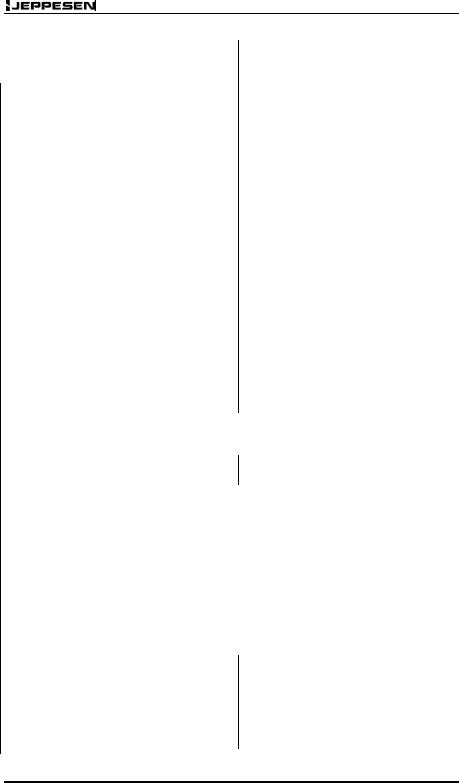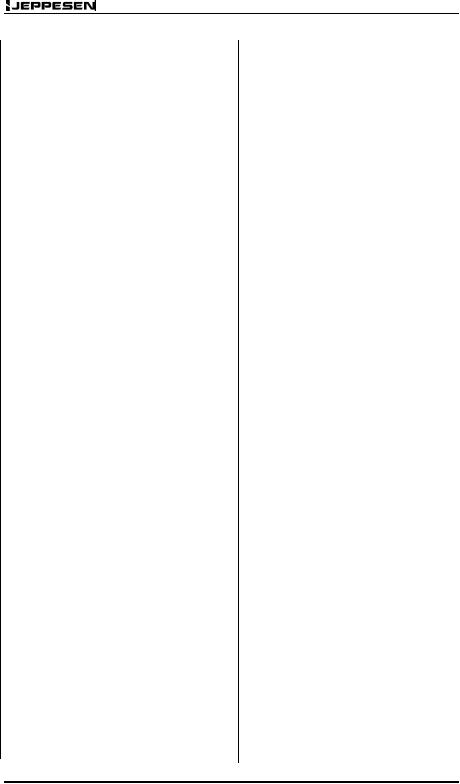
- •TABLE OF CONTENTS
- •DEFINITIONS
- •CHAPTER 6 – FORECASTS
- •APPENDIX 1. FLIGHT DOCUMENTATION - MODEL CHARTS AND FORMS
- •SYMBOLS FOR SIGNIFICANT WEATHER
- •APPENDIX 5. TECHNICAL SPECIFICATIONS RELATED TO FORECASTS
- •MET BROADCASTS IN PLAIN LANGUAGE - EUROPE
- •TELEPHONE/FAX NUMBERS AND HOURS OF OPERATIONS OF MET STATIONS
- •MET BROADCASTS IN PLAIN LANGUAGE - EASTERN EUROPE

12 |
METEOROLOGY |
25 FEB 05 |
METEOROLOGICAL SERVICE FOR INTERNATIONAL AIR NAVIGATION - ANNEX 3
CHAPTER 6 – FORECASTS
NOTE: Technical specifications and detailed criteria related to this chapter are given in Appendix 5.
6.1INTERPRETATION AND USE OF FORECASTS
6.1.1Owing to the variability of meteorological elements in space and time, to limitations of forecasting techniques and to limitations caused by the definitions of some of the elements, the specific value of any of the elements given in a forecast shall be understood by the recipient to be the most probable value which the element is likely to assume during the period of the forecast. Similarly, when the time of occurrence or change of an element is given in a forecast, this time shall be understood to be the most probable time.
6.1.2The issue of a new forecast by a meteorological office, such as a routine aerodrome forecast, shall be understood to cancel automatically any forecast of the same type previously issued for the same place and for the same period of validity or part thereof.
6.2AERODROME FORECASTS
6.2.1An aerodrome forecast shall be prepared by the meteorological office designated by the meteorological authority concerned.
6.2.2An aerodrome forecast shall be issued at a specified time and consist of a concise statement of the expected meteorological conditions at an aerodrome for a specified period.
6.2.3Aerodrome forecasts and amendments thereto shall be issued as TAF and include the following information in the order indicated:
a.identification of the type of forecast;
b.location indicator;
c.time and issue of forecast;
d.identification of a missing forecast, when applicable;
e.date and period of validity of forecast;
f.identification of a cancelled forecast, when applicable;
g.surface wind;
h.visibility;
i.weather;
j.cloud; and
k.expect significant changes to one or more of these elements during the period of validity.
Optional elements shall be included in TAF in accordance with regional air navigation agreement.
NOTE: The visibility included in TAF refers to the forecast prevailing visibility.
6.2.4 Meteorological offices preparing aerodrome forecasts shall keep the forecasts under continuous review and, when necessary, shall issue amendments promptly. The length of the forecast messages and the number of changes indicated in the forecast shall be kept to a minimum.
6.2.5TAF cannot be kept under continuos review shall be cancelled.
6.2.6Recommendation – The period of validity of routine aerodrome forecasts should be not less than 9 hours nor more than 24 hours; this period should be determined by regional air navigation agreement. Routine TAF valid for less than 12 hours should be issued every 3 hours and those valid for 12 to 24 hours should be issued every 6 hours.
6.3LANDING FORECASTS
6.3.1A landing forecast shall be prepared by the meteorological office designated by the meteorological authority concerned; such forecasts are intended to meet requirements of local users and of aircraft within about one hour’s flying time from the aerodrome.
6.3.2Landing forecasts shall be prepared in the form of a trend forecast, as determined by regional air navigation agreement.
6.3.3A trend forecast shall consist of a concise statement of expected significant changes in the meteorological conditions at that aerodrome to be appended to a local routine or local special report, or a METAR or SPECI. The period of validity of a trend forecast shall be 2 hours from the time of the report which forms part of the landing forecast
6.4FORECASTS FOR TAKE-OFF
6.4.1A forecast for take-off shall be prepared by the meteorological office designated by the meteorological authority concerned.
6.4.2Recommendation – A forecast for take-off should refer to a specified period of time and should contain information on expected conditions over the runway complex in regard to surface wind direction and speed and any variations thereof, temperature, pressure (QNH), and any other elements as agreed locally.
6.4.3Recommendation – A forecast for take-off should be supplied to operators and flight crew members on request within the 3 hours before the expected time of departure.
6.4.4Recommendation – Meteorological offices preparing forecasts for take-off should keep the forecasts under continuos review and, when necessary, should issue amendments promptly.
6.5AREA AND ROUTE FORECASTS, OTHER THAN FORECASTS ISSUED WITHIN THE FRAMEWORK OF THE WORLD AREA FORECAST SYSTEM
NOTE: Provisions concerning forecasts issued within the framework of the world area forecast system are contained in Chapter 3 and those concerning area forecasts for low-level flights, under Section 6.6.
© JEPPESEN SANDERSON, INC., 1999, 2005. ALL RIGHTS RESERVED.

25 FEB 05 |
METEOROLOGY |
13 |
METEOROLOGICAL SERVICE FOR INTERNATIONAL AIR NAVIGATION - ANNEX 3
6.5.1Area and route forecasts shall contain upper winds, upper-air temperatures, significant en route weather phenomena and associated clouds. Other elements may be added as required. This information shall cover the flight operations for which they are intended in respect of time, altitude and geographical extent.
6.5.2Meteorological offices preparing area and route forecasts shall keep the forecasts under continuous review and issue amendments as necessary.
6.6AREA FORECASTS FOR LOW-LEVEL FLIGHTS
6.6.1Recommendation – When the density of traffic operating below flight level 100 (or up to flight level 150 in mountainous areas, or higher, where necessary) warrants the routine issue and dissemination of area forecasts for such operations, the frequency of issue, the form and the fixed time or period of validity of those forecasts and the criteria of amendments thereto should be determined by the meteorological authority in consultation with the users.
6.6.2When the density of traffic operating below flight level 100 warrants the issuance of AIRMET information in accordance with 7.2.1, area forecasts for such operations shall be prepared in a format agreed upon between the meteorological authorities concerned. When abbreviated plain language is used, the forecast shall be prepared as a GAMET area forecast, employing approved ICAO abbreviations and numerical values.Thwe area forecasts shall be issued to cover the layer between ground and flight level 100 (or up to flight level 150 in mountainous areas, or higher, where necessary) and shall contain information on en-route weather phenomena hazardous to low-level flights, in support of the issuance of AIRMET information, and additional information required by low-level flights.
6.6.3Area forecasts for low-level flights prepared in support of the issuance of AIRMET information shall be issued every 6 hours and transmitted to meteorological offices concerned not later than one hour prior to the beginning of their validity period.
CHAPTER 7 – SIGMET AND AIRMET INFORMATION, AERODROME WARNINGS AND WIND SHEAR WARNINGS
NOTE: Technical specifications and detailed criteria related to this chapter are given in Appendix 6.
7.1SIGMET INFORMATION
7.1.1 SIGMET information shall be issued by a meteorological watch office and shall give a concise description in abbreviated plain language concerning the occurrence and/or expected occurrence of specified en route weather phenomena, which may affect the safety of aircraft operations, and of the development of those phenomena in time and space.
7.1.2SIGMET information shall be cancelled when the phenomena are no longer occurring or are no longer expected to occur in the area.
7.1.3SIGMET information shall be cancelled when the phenomena are no longer occurring or are no longer expected to occur in the area.
7.1.4Recommendation – In the special case of SIGMET messages for volcanic ash cloud and tropical cyclones, an outlook should be included giving information for up to 12 hours beyond the period of validity specified in 7.1.3, concerning the trajectory of the volcanic ash cloud and positions of the tropical cyclone center.
7.1.5Recommendation – SIGMET messages issued in accordance with 7.1.4 concerning volcanic ash cloud and tropical cyclones should be based on advisory information provided by VAACs and TCACs respectively, designated by regional air navigation agreement.
7.1.6Close coordination shall be maintained between the meteorological watch office and the associated area control center/flight information center to ensure that information on volcanic ash cloud included in SIGMET and NOTAM messages is consistent.
7.1.7A SIGMET message relating to the expected occurrence of weather phenomena listed in Appendix 6, 1.1.4 with the exception of volcanic ash cloud and tropical cyclones, shall be issued not more than 6 hours, preferably not more than 4 hours, before the expected time of occurrence of that phenomenon.
7.1.8Recommendation – SIGMET messages concerning volcanic ash cloud or tropical cyclones expected to affect a flight information region should be issued up to 12 hours before the commencement of the period of validity or as soon as practicable if such advance warning of the existence of these phenomena is not available. SIGMET messages for volcanic ash cloud and tropical cyclones should be updated at least every 6 hours.
7.2AIRMET INFORMATION
7.2.1AIRMET information shall be issued by a meteorological watch office in accordance with regional air navigation agreement, taking into account the density of the air traffic operating below flight level 100. AIRMET information shall give a concise description in abbreviated plain language concerning the occurrence and/or expected occurrence of specified en-route weather phenomena, which have not been included in Section I of the area forecast for low-level flights issued in accordance with Chapter 6, sction6.6 and which may affect the safety of low-level flights, and of the development of those phenomena in time and space.
7.2.2AIRMET information shall be cancelled when the phenomena are no longer occurring or are no longer expected to occur in the area.
7.2.3The period of validity of an AIRMET message shall be not more than 6 hours, and preferably not more than 4 hours.
© JEPPESEN SANDERSON, INC., 1999, 2005. ALL RIGHTS RESERVED.

14 |
METEOROLOGY |
25 FEB 05 |
METEOROLOGICAL SERVICE FOR INTERNATIONAL AIR NAVIGATION - ANNEX 3
7.3AERODROME WARNINGS
7.3.1Aerodrome warnings shall be issued by the meteorological office designated by the meteorological authority concerned and shall give concise information of meteorological conditions which could aversely affect aircraft on the ground, including parked aircraft, and the aerodrome facilities and services.
7.3.2Recommendation – Aerodrome warnings should be cancelled when the conditions are no longer occurring and/or no longer expected to occur at the aerodrome
7.4WIND SHEAR WARNINGS
7.4.1 Wind shear warnings shall be prepared by the meteorological office designated by the meteorological authority concerned and shall give concise information of the observed or expected existence of wind shear which could adversely affect aircraft on the approach between runway level and 500m (1600ft) above that level and aircraft on the runway during the landing roll or take-off run. Where local topography has been shown to produce significant wind shears at heights in excess of 500m (1600ft) above runway level, then 500m (1600ft) shall not be considered restrictive.
NOTE: Guidance on the subject of wind shear is contained in the Manual on Wind Shear (DOC 9817, in preparation).
7.4.2 Recommendation – Wind shear warnings for arriving aircraft and/or departing aircraft should be cancelled when aircraft reports indicate that wind shear no longer exists, or alternatively, after an agreed elapsed time. The criteria for the cancellation of a wind shear warning should be defined locally for each aerodrome, as agreed between the meteorological authority, the appropriate ATS authority and the operators concerned.
CHAPTER 8 - AERONAUTICAL CLIMATOLOGICAL INFORMATION
NOTE: Technical specifications and detailed criteria related to this chapter are given in Appendix 7
8.1GENERAL PROVISIONS
NOTE: In cases where it is impracticable to meet the requirements for aeronautical climatological information on a national basis, the collection, processing and storage of observational data may be affected through computer facilities available for international use, and the responsibility for the preparation of required aeronautical climatological information may be delegated by agreement between the meteorological authorities concerned.
8.1.1 Aeronautical climatological information required for the planning of flight operations shall be prepared in the form of aerodrome climatological tables and aerodrome climatological summaries. Such information shall be supplied to aeronautical users agreed between the meteorological authority and those users.
NOTE: Climatological data required for aerodrome planning purposes are set out in Annex 14, Volume I, 3.1.3.
8.1.2Recommendation – Aeronautical climatological information should normally be based on observations made over a period of at least 5 years and the period should be indicated in the information supplied.
8.1.3Recommendation – Climatological data related to sites for new aerodromes and to additional runways at existing aerodromes should be collected starting as early as possible before commissioning of those aerodromes or runways.
8.2 AERODROME CLIMATOLOGICAL TABLES
Recommendation – Each Contracting State should made arrangements for collecting and retaining the necessary observational data and have the capability:
a.to prepare aerodrome climatological tables for each regular and alternate international aerodrome within its territory; and
b.to make available such climatological tables to an aeronautical user within a time period as agreed between the meteorological authority and that user.
8.3 AERODROME CLIMATOLOGICAL SUMMARIES
Recommendation – Aerodrome climatological summaries should follow the procedures prescribed by the World Meteorological Organization. Where computer facilities are available to store, process and retrieve the information, the summaries should be published, or otherwise made available to aeronautical users on request. Where such computer facilities are not available, the summaries should be prepared using the models specified by the World Meteorological Organization, and should be published and kept up to date as necessary.
8.4 COPIES OF METEOROLOGICAL OBSERVATIONAL DATA
Each meteorological authority, on request and to the extent practicable, shall make available to any other meteorological authority, to operators and to others concerned with the application of meteorology to international air navigation, meteorological observational data required for research, investigation or operational analysis.
CHAPTER 9 - SERVICE FOR OPERATORS AND FLIGHT CREW MEMBERS
9.1GENERAL PROVISIONS
9.1.1 Meteorological information shall be supplied to operators and flight crew members for:
a.pre-flight planning by operators;
b.in-flight re-planning by operators using centralized operational control of flight operations;
© JEPPESEN SANDERSON, INC., 1999, 2005. ALL RIGHTS RESERVED.

25 FEB 05 |
METEOROLOGY |
15 |
METEOROLOGICAL SERVICE FOR INTERNATIONAL AIR NAVIGATION - ANNEX 3
c.use by flight crew members before departure; and
d.aircraft in flight.
9.1.2Meteorological information supplied to operators and flight crew members shall cover the flight in respect of time, altitude and geographical extent. Accordingly, the information shall relate to appropriate fixed times, or periods of time, and shall extent to the aerodrome of intended landing, also covering the meteorological conditions expected between the aerodrome of intended landing and one alternate aerodrome designated by the operator. In addition, if agreed between numerological authority and the operator, information up to a further aerodrome shall be supplied
9.1.3Meteorological information supplied to operators and flight crew members shall include upper winds and upper-air temperatures, significant en route weather phenomena, METAR and SPECI (including trend forecasts), TAF, forecasts for take-off, SIGMET information and those special air-reports not covered by a SIGMET, and AIRMET information, which are available at the meteorological office and which are relevant to the planned flight operations.
9.1.4Where necessary, the meteorological authority of the State providing service for operators and flight crew members shall initiate coordinating action with the meteorological authorities of other States with a view to obtaining from them reports and/or forecasts required.
9.1.5Meteorological information shall be supplied to operators and flight crew members at the location to be determined by the meteorological authority, after consultation with the operators and the time to be agreed upon between the meteorological office and the operator concerned. The service shall normally be confined to flights originating within the territory of the State concerned, unless otherwise agreed between the meteorological authority and the operator concerned. At an aerodrome without a meteorological office, arrangements for the supply of meteorological information shall be as agreed upon between the meteorological authority and the operator concerned.
9.2INFORMATION FOR OPERATORS FOR PRE-FLIGHT PLANNING AND FOR IN-FLIGHT RE-PLANNING UNDER CENTRALIZED OPERATIONAL CONTROL
9.2.1 Meteorological information for pre-flight planning and in-flight re-planning by operators shall include any or all of the following information, as established by the meteorological authority in consultation with operators concerned:
a.current and forecast: upper winds, upper-air temperatures and humidity;
b.tropopause height and temperature, and direction, speed and height of maximum wind;
c.existing and expected significant en route weather phenomena and amendments thereto;
d.forecast for take-off;
e.METAR and, where available, SPECI (including trend forecasts) for the aerodrome of departure, take-off and en route alternate aerodromes, the aerodrome of intended landing and destination alternate aerodromes, as determined by regional air navigation agreement;
f.TAF and amendments thereto for the aerodromes of departure and intended landing, and for take-off, en route and destination alternate aerodromes as determined by regional air navigation agreement;
g.SIGMET information and appropriate special air-reports relevant to the whole of the routes concerned as determined by regional air navigation agreement, and;
NOTE: Appropriate special air-reports will be those not already used in preparation of SIGMET messages.
h.AIRMET information for low-level flights are determined by regional air navigation agreement.
9.2.2When upper-air information is supplied in chart form, it shall consist of charts for standard flight levels.
9.2.3Recommendation – The upper wind and upper-air temperature information and the significant en route weather information requested for pre-flight planning and in-flight re-planning by the operator should be supplied as soon as it becomes available, but not later than 3 hours before departure. Other meteorological information requested for pre-flight planning and in-flight re-planning by the operator should be supplied as soon as is practicable.
9.3BRIEFING, CONSULTATION AND DISPLAY
NOTE: The requirements for the use of automated preflight information systems in providing briefing, consultation and display are given in 9.5...
9.3.1Briefing and/or consultation shall be provided, on request, to flight crew members and/or other flight operations personnel. Its purpose shall be to supply the latest available information on existing and expected meteorological conditions along the route to be flown, at the aerodrome of intended landing, alternate aerodromes and other aerodromes as relevant, either to explain and amplify the information contained in the flight documentation or, if so agreed between the meteorological authority and the operator, in lieu of flight documentation.
9.3.2Meteorological information used for briefing and consultation shall include any or all of the information listed in 9.2.1.
9.3.3If the meteorological office expresses an opinion on the development of the meteorological conditions at an aerodrome which differs appreciably from the aerodrome forecast included in the flight documentation, the attention of flight crew members shall be drawn to the divergence. The portion of the briefing dealing with the divergence shall be recorded at the time of briefing and this record shall be made available to the operator.
© JEPPESEN SANDERSON, INC., 1999, 2005. ALL RIGHTS RESERVED.

16 |
METEOROLOGY |
25 FEB 05 |
METEOROLOGICAL SERVICE FOR INTERNATIONAL AIR NAVIGATION - ANNEX 3
9.3.4The required briefing, consultation, display and/or flight documentation shall normally be provided by the meteorological office associated with the aerodrome of departure. At an aerodrome where these facilities are not available, arrangements to meet the requirements of flight crew members shall be as agreed upon between the meteorological authority and the operator concerned. In exceptional circumstances, such as an undue delay, the meteorological office associated with the aerodrome shall provide or, if that is not practicable, arrange for the provision of a new briefing, consultation and/or flight documentation as necessary.
9.3.5Recommendation – The flight crew member or other flight operations personnel for whom briefing, consultation and/or flight documentation has been requested should visit the meteorological office at the time agreed upon between the meteorological office and the operator concerned. Where local circumstances at an aerodrome make personal briefing or consultation impracticable, the meteorological office should provide these services by telephone or suitable telecommunication facilities.
9.4FLIGHT DOCUMENTATION – GENERAL
NOTE: The requirements for the use of automated preflight information systems in providing flight documentation are given in 9.5.
9.4.1Recommendation – Flight documentation should cover the whole route to be flown and comprise information listed under 9.2 a., c., and e. to h. However, in accordance with regional air navigation agreement, or in the absence thereto when agreed between the meteorological authority and the operator concerned, flight documentation for flights of two hours duration or less, after a short stop or turn around should be limited to the information operationally needed, but in all cases the flight documentation should at least comprise the information on 9.2.1 e., f., g. and if appropriate, h.
9.4.2Recommendation – Meteorological offices should, as far as practicable, provide information received within the framework of the world area forecast system for flight documentation. The flight documentation should be presented in the form of charts, tabular forms, or abbreviated plain-language texts. Aerodrome forecasts should be presented in the TAF code, or in abbreviated plain-language text using a tabular presentation.
NOTE: Models of charts and forms for use in the preparation of flight documentation are given in Appendix 1. These models and methods for their completion are developed by the World Meteorological Organization on the basis of relevant operational requirements stated by the International Civil Aviation Organization.
9.4.3. Whenever it becomes apparent that the meteorological information to be included in the flight documentation will differ materially from that made available for pre-flight planning and in-flight re-planning, the operator shall be advised immediately and, if practicable, be supplied with the revised
information as agreed between the operator and the meteorological office concerned.
9.4.4Recommendation – Whenever necessary and possible, the flight documentation should be brought up to date, in writing or orally, before it is supplied to flight crew members. In cases where a need for amendment arises after the flight documentation has been supplied, and before take-off of the aircraft, the meteorological office should, as greed locally, issue the necessary amendment or updated information to the operator or to the local air traffic services unit, for transmission to the aircraft.
9.4.5Recommendation – The forms and charts included in flight documentation should be printed in English, French, Russian or Spanish; they should, wherever practicable, be completed in the language requested by the operator, preferably using one of those languages. Where appropriate, approved abbreviations should be used. The units employed for each element should be indicated; they should be in accordance with Annex 5.
9.5AUTOMATED PRE-FLIGHT INFORMATION SYSTEMS FOR BRIEFING, CONSULTATION, FLIGHT PLANNING AND FLIGHT DOCUMENTATION
9.5.1Where the meteorological authority uses automated pre-flight information systems to supply and display meteorological information to operators and flight crew members for self-briefing, flight planning and flight documentation purposes, the information supplied and displayed shall comply with the relevant provisions in 9.1 to 9.4 inclusive.
9.5.2Recommendation – Automated pre-flight information systems providing for a harmonized, common point of access to meteorological information and aeronautical information services information by operators, flight crew members and other aeronautical personnel concerned should be established by an agreement between the meteorological authority and the relevant civil aviation authority or the agency to which the authority provide service has been delegated in accordance with Annex 15, 3.1.1 c.
NOTE: The meteorological and aeronautical information services information concerned is specified in 9.1 to 9.4 and Appendix 8 and in Annex 15, 8.1 and 8.2 respectively.
9.5.3 Where automated pre-flight information systems are used to provide a harmonized, common point of access to meteorological information and aeronautical information services information by operators, flight crew members and other aeronautical personnel concerned, the meteorological authority concerned shall remain responsible for the quality control and quality management if meteorological information by means of such systems in accordance with Chapter2, 2.2.2
© JEPPESEN SANDERSON, INC., 1999, 2005. ALL RIGHTS RESERVED.

|
25 FEB 05 |
METEOROLOGY |
17 |
||
|
METEOROLOGICAL SERVICE FOR INTERNATIONAL AIR NAVIGATION - ANNEX 3 |
||||
NOTE: The responsibilities relating to aeronautical |
10.2 |
INFORMATION FOR SEARCH AND RES- |
|||
information services information and the quality as- |
CUE SERVICES UNITS |
||||
surance of the information is given in Annex 15, |
Meteorological offices designated by the meteoro- |
||||
Chapter 3. |
|
logical authority in accordance with regional air navi- |
|||
9.6 INFORMATION FOR AIRCRAFT IN |
gation agreement shall supply search and rescue |
||||
services units with the meteorological information |
|||||
|
FLIGHT |
|
|||
|
|
they require in a form established by mutual agree- |
|||
9.6.1 |
Meteorological information for use by air- |
ment. For that purpose, the designated meteorologi- |
|||
cal office shall maintain liaison with the search and |
|||||
craft in flight shall be supplied by a meteorological |
|||||
rescue services unit throughout a search and rescue |
|||||
office to its associated air traffic services unit and |
|||||
operation. |
|||||
through D-VOLMET or VOLMET broadcasts. Meteo- |
|||||
10.3 |
INFORMATION FOR AERONAUTICAL IN- |
||||
rological information for planning by the operator for |
|||||
aircraft in flight shall be supplied on request, as |
FORMATION SERVICES UNITS |
||||
agreed between the meteorological authority or au- |
The meteorological authority, in coordination with |
||||
thorities and the operator concerned. |
|
||||
|
the appropriate civil aviation authority, shall arrange |
||||
|
|
|
|||
9.6.2 |
Meteorological information for use by air- |
for the supply of up-to-date meteorological informa- |
|||
craft on flight shall be supplied to air traffic services |
tion to relevant aeronautical information services |
||||
units in accordance with specifications of Chapter |
units, as necessary, for the conduct of their func- |
||||
10. |
|
|
tions. |
|
|
9.6.3 |
Meteorological information shall be sup- |
CHAPTER 11REQUIREMENTS FOR |
|||
plied through D-VOLMET or VOLMET broadcast as |
|||||
determined by regional air navigation agreement, |
AND USE OF COMMUNICATIONS |
||||
and in accordance with the specifications of Chapter |
|
|
|||
11. |
|
|
NOTE 1: Technical specification and detailed criteria |
||
|
|
|
related to this chapter are given in Appendix10. |
||
CHAPTER 10 - INFORMATION FOR AIR TRAFFIC SERVICES, SEARCH AND RESCUE SERVICES AND AERONAUTICAL INFORMATION SERVICES
NOTE 2: It is recognized that it is for each Contracting State to decide upon it own internal organization and responsibility for implementing the telecommunication facilities referred to this chapter.
11.1 REQUIREMENTS FOR COMMUNICATIONS
NOTE: Technical specifications and detailed criteria related to this chapter are given in Appendix 9.
10.1 INFORMATION FOR AIR TRAFFIC SERVICES UNITS
11.1.1 Suitable telecommunications facilities shall be made available to permit aerodrome meteorological offices and, as necessary, aeronautical meteorological stations to supply the required meteorological information to air traffic services units on the
10.1.1The meteorological authority shall desigaerodromes for which those offices and stations are
nate a meteorological office to be associated with each air traffic services unit. The associated meteorological office shall, after coordination with air traffic services unit, supply, or arrange for the supply of up-t-date meteorological information to the unit necessary for the conduct of its function.
10.1.2Recommendation – The associated meteorological office for an aerodrome control tower or approach control office should be an aerodrome meteorological office.
10.1.3The associated meteorological office for a flight information center or area control center shall be a meteorological watch office.
10.1.4Recommendation – Where, owing to local circumstances, it is convenient for the duties of an associated meteorological office to be shared between two or more meteorological offices, the division of responsibility should be determined by the meteorological authority in consultation with the appropriate ATS authority.
10.1.5Any meteorological information requested by an air traffic services unit in connection with an aircraft emergency shall be supplied as rapidly as possible.
responsible, and in particular to aerodrome control towers, approach control offices and the aeronautical telecommunications stations serving these aerodromes.
NOTE: Circuits of the aeronautical fixed service are used for the collection and regional and inter-region- al exchanges of operational meteorological information as well as for access to international operational meteorological data banks. Three aeronautical fixed service satellite distribution systems providing for global coverage are used to support the regional and inter-regional exchanges of operational meteorological information. Provisions relating to the satellite distribution systems are given in Annex 10, Volume III, part 1, 10.1 and 10.2.
11.1.2 Suitable telecommunications facilities shall be made available to permit meteorological watch offices to supply the required meteorological information to air traffic services and search and rescue services units in respect of the flight information regions, control areas and search and rescue regions for which those offices are responsible, and in particular to flight information centers, area control centers and rescue coordination centers and the associated aeronautical telecommunications stations.
© JEPPESEN SANDERSON, INC., 1999, 2005. ALL RIGHTS RESERVED.

18 |
METEOROLOGY |
25 FEB 05 |
METEOROLOGICAL SERVICE FOR INTERNATIONAL AIR NAVIGATION - ANNEX 3
11.1.3Suitable telecommunication facilities shall be made available to permit world area forecast centers to supply the required world area forecast system products to meteorological offices, meteorological authorities and other users.
11.1.4Telecommunication facilities between meteorological offices and, as necessary, aeronautical meteorological stations and aerodrome control towers or approach control offices shall permit communications by direct speech, the speed with which the communications can be established being such that required points may normally be contacted within approximately 15 seconds.
11.1.5Recommendation – Telecommunication facilities between meteorological offices and flight information centers, area control centers, rescue coordination centers and aeronautical telecommunication stations should permit:
a.communications by direct speech, the speed with which the communications can be established being such that the required points may normally be contacted within approximately 15 seconds; and
b.printed communications, when a record is required by the recipient; the message transmit time should not exceed 5 minutes.
NOTE: In 11.1.4 and 11.1.5 ‘approximately 15 seconds’ refers to telephony communications involving switchboard operation and ‘5 minutes’ refer to printed communications involving transmission.
11.1.6Recommendation – The telecommunication facilities required in accordance with 11.1.4 and 11.1.5 should be supplemented, as and where necessary, by other forms of visual or audio communications, for example, closed-circuit television or separate information processing systems.
11.1.7Recommendation – As agreed between the meteorological authority and operators, provision should be made to enable operators to establish suitable telecommunications facilities for obtaining meteorological information from aerodrome meteorological offices or other appropriate sources.
11.1.8Recommendation – Suitable telecommunications facilities shall be made available to permit meteorological offices to exchange operational meteorological information with other meteorological offices.
11.1.9Recommendation – The telecommunications facilities used for the exchange of operational meteorological information should be the aeronautical fixed service.
11.2 USE OF AERONAUTICAL FIXED SERVICE COMMUNICATIONS - METEORLOGICAL BULLETINS IN ALPHANUMERIC FORMAT
Meteorological bulletins containing operational meteorological information to be transmitted via aeronautical fixed service shall be originated by the appropriate meteorological office or aeronautical meteorological station.
NOTE: Meteorological bulletins containing operational meteorological information authorized for
transmission via aeronautical fixed service are listed in Annex 10, Volume II, Chapter 4, together with the relevant priorities and priority indicator.
11.3 USE OF AERONAUTICAL FIXED SERVICE COMMUNICATIONS - WORLD AREA FORECAST SYSTEM PRODUCTS
Recommendation – World area forecast system products in digital form should be transmitted using binary data communication techniques. The method and channels used for dissemination of the products should be as determined by regional air navigation agreement.
11.4 USE OF AERONAUTICAL MOBILE SERVICE COMMUNICATION
The content and format of meteorological information transmitted to aircraft and by aircraft shall be consistent with the provisions of this Annex.
11.5 USE OF AERONAUTICAL DATA LINK SERVICE - CONTENTS OF D-VOLMET
D-VOLMET shall contain current METAR and SPECI together with trend forecasts where available, TAF and SIGMET, special air-reports not covered by SIGMET and, where available, AIRMET.
NOTE: The requirement to provide METAR and SPECI may be met by the data-link information service (D-FIS) application entitled ‘Data link-aero- drome routine meteorological report (D-METAR) service’; the requirement to provide TAF may be met by the D-FIS application entitled ‘Data link-aerodrome forecast (D-TAF) service’; and the requirement to provide SIGMET and AIRMET messages may be met by the D-FIS application entitled ‘Data link-SIG- MET (D-SIGMET) service’. The details of these data link services are specified in the Manual of Air Traffic Services Data Link Applications (Doc 9694).
11.6 USE OF AERONAUTICAL BROADCAST SERVICE - CONTENTS OF VOLMET BROADCASTS
11.6.1Continuous VOLMET broadcasts, normally on very high frequencies (VHF) shall contain current METAR and SPECI, together with trend forecasts where available.
11.6.2Scheduled VOLMET broadcasts, normally on high frequencies (HF), shall contain current METAR and SPECI, together with trend forecasts where available and, where so determined by regional air navigation agreement, TAF and SIGMET.
© JEPPESEN SANDERSON, INC., 1999, 2005. ALL RIGHTS RESERVED.
